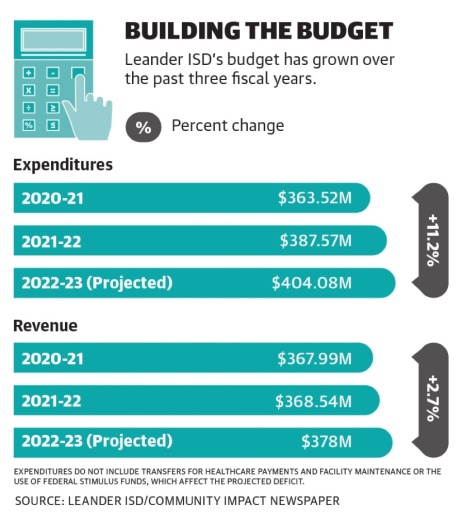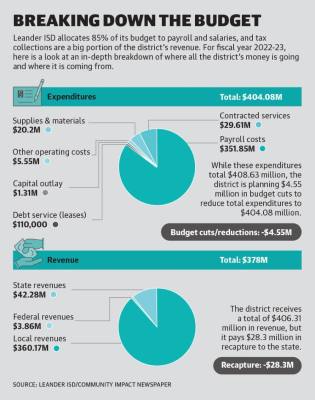“We have nearly $12 million budgeted for salary increases, and then with student growth, we hire additional teachers,” LISD Chief Financial Officer Elaine Cogburn said.
For fiscal year 2022-23, Leander ISD is predicting roughly $378 million in total revenues net of recapture and about $404 million in total operating expenditures. The board plans to adopt the finalized budget no later than June 23.
The only cuts being made in next year’s budget are vacant positions, Cogburn said.
“It’s really important not to cut this year any student-facing positions,” LISD board member Gloria Gonzalez-Dholakia said at the April 7 meeting. “We had people out for a long time with COVID[-19] and quarantine. It’s just not the year for us to make those types of decisions.”
Bond elections are not a “huge driver of the budget,” Cogburn said, but last year’s bond failure does have an impact on the district.
Bond rebound
Last November, the district had a $772 million bond package up for election, when two out of three propositions failed. Voters only approved Proposition B, which provides $33.3 million in funding for technology equipment.
Proposition A—which would have allocated $727.2 million to build new schools and facilities—failed by 215 votes. The projects under Proposition A were necessary in accommodating future enrollment growth, according to the district staff. Proposition C, which would have provided $11.7 million for lighting and sound upgrades at performing arts centers, failed by 765 votes.
“When the bond failed, the projects that were planned didn’t happen,” board President Trish Bode said. “So we don’t have those schools going up to address the exponential growth our district is seeing.”
Addressing enrollment growth
For the upcoming school year, LISD is expecting roughly 1,900 new students for the 2022-23 school year. By 2031, the district could have more than 9,000 additional students.
Proposition A in the 2021 bond would have allowed LISD to build four new elementary schools.
Based on a 2021 demographic report, the district could need eight total new schools over the next 10 years. The additional schools include six elementary schools, one middle school and one high school.
Until LISD decides to call another bond election, other solutions have been in the conversation to address the growing student population in the meantime. The district could either rezone campuses to relieve overpopulated ones or add portables to campuses to increase the overall capacity.
The district’s enrollment growth brings in more revenue because there are more students to serve, Cogburn said. However, the more students—depending on the age—the greater need for more facilities, which is an operational cost.
“It’s a balancing act of making sure that you can serve those students in the facilities either with what you have or reusing the facilities that you have so you don’t have to build more or eventually having to build more,” Cogburn said.
Next steps
In addition to rezoning and adding portables to overflowing campuses, LISD is still considering another bond election. The board selects members to serve on the Long-Range Planning Committee and the Citizens’ Facility Advisory Committee to assist with the planning.
The CFAC reviews facility needs and makes recommendations for future bond election packages, which go to the board for final approval before being presented to voters.
The LRPC is responsible for developing a 10-year facilities plan centered on student learning. The committee will hold meetings to assess the possibility of a November or May 2023 bond election. The committee is expected to have it finalized by this summer.
“Even if we did call a November bond election and even if the bond passed, we’re not going to be able to build that school any faster than if we passed that bond election in May,” board Trustee Aaron Johnson said in the April 21 meeting.
For last year’s bond election, the process took seven months for discussion, planning and presenting the recommendations to the board. If the board were to call another bond election in November, the timeline would be compressed into four months. A May 2023 bond election gives the board and the committees seven months to prepare.
LISD is planning to hold three other elections in November, including a voter-approval tax rate election, or VATRE, which would ask voters to approve lowering the overall tax rate. The VATRE would increase the tax rate for maintenance and operations, or M&O, while lowering the tax rate for interest and sinking, or I&S—essentially providing the district with more funds for operations. The VATRE could provide LISD at least $20 million in revenue if approved.
The I&S tax rate funds allow the district to complete major projects and build facilities, while the M&O primarily funds salaries, insurance and benefits for employees.
The district will have five board seats up for election. It is also anticipating holding a state-required attendance credit election, which would ask voters to enable LISD to continue to make mandatory recapture payments, Cogburn said.
“We’re looking at a school opening August of 2024,” LISD Superintendent Bruce Gearing said. “Regardless of whether we go November or May [for the bond election], the school openings have been planned for 2024.”







